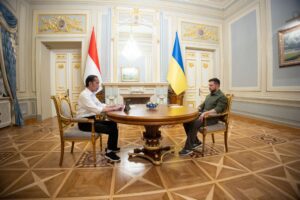
Ukraine in January-September this year reduced imports of nickel ores and concentrate in kind by 63.9% compared to the same period last year – up to 328.936 thousand tons.
According to statistics released by the State Customs Service (STS), in monetary terms, imports of nickel ores decreased by 65.7% to $14.796 million.
At the same time, the import was carried out from Guatemala (100% of deliveries in terms of money).
For the nine months of 2022, as in January-September 2021, Ukraine did not export and re-export these products.
As reported, Ukraine in 2021 reduced the import of nickel ores and concentrate in physical terms by 20.6% compared to 2020 – to 1 million 235.533 thousand tons. In monetary terms, imports of nickel ores decreased by 22.2% to $58.929 million. Imports were carried out from Guatemala (100% of deliveries in monetary terms).
Last year, Ukraine did not export and re-export these products.
Nickel ore is imported to Ukraine by the Pobuzhsky ferronickel plant (PFC, part of the Solway group).
PFC processes about 1.2 million tons of ore per year.

Ukraine in January-September this year reduced the import of manganese ore and concentrate in kind by 54.1% compared to the same period last year – up to 135.044 thousand tons.
According to statistics published by the State Customs Service (STS), in monetary terms, imports of manganese ore and concentrate for the specified period decreased by 50.7% – to $17.972 million.
In August-September, manganese ore was practically not imported.
At the same time, for the nine months of 2022, imports were carried out from Ghana (99.86% of supplies in monetary terms) and Belgium (0.1%) and Brazil (0.02%).
For nine months of 2022, Ukraine did not supply manganese ore and concentrate for export.
As reported, Ukraine in 2021 reduced the import of manganese ore and concentrate in physical terms by 26.8% compared to 2020, to 425.279 thousand tons. In monetary terms, imports of manganese ore and concentrate over the specified period decreased by 29.6% to $53.917 million. At the same time, the main imports were from Ghana (99.87% of supplies in monetary terms), Brazil (0.07%) and Belgium ( 0.05%).
Last year, Ukraine supplied 770 tons of manganese ore and concentrate to Poland (94.38%) and the Russian Federation (5.62%) in the amount of $89 thousand, while in 2020 it exported 69.303 thousand tons of manganese ore and concentrate to $10.819 million
In Ukraine, manganese ore is mined and enriched by Pokrovsky (formerly Ordzhonikidzevsky) and Marganets mining and processing plants (both – Dnepropetrovsk region).
The consumers of manganese ore are ferroalloy enterprises.

Prices of precious metals continue to decline on inflation data in the US and against the background of the strengthening of the US national currency, as a result, gold may end the first week of the last three in the red, MarketWatch reports.
Gold and silver “continue to trade in a strong inverse relationship with the strong dollar index,” said Jim Wyckoff, senior analyst at Kitco.com. At the same time, market bulls are surprised that precious metals do not attract investors as a “safe harbor” in the face of increased geopolitical and market uncertainty, he said.
Quotes of December contracts for gold on the Comex during trading on Friday decreased by 1.3% – up to $1654.9 per troy ounce. Silver for December delivery fell 2.8% to $18.39 an ounce. Since the beginning of the week, the cost of these precious metals has fallen by 3.1% and 8.8%, respectively.
December palladium futures fell 3% on Friday to $2,053.5 an ounce.
Meanwhile, the DXY index, which shows the value of the US dollar against six major world currencies, rose by 0.7% to 113.14 points.
Consumer prices (CPI index) in the US in September rose by 8.2% compared to the same month last year, showed data published on Thursday by the country’s Ministry of Labor. Thus, inflation slowed down compared to 8.3% in August, but turned out to be higher than the 8.1% expected by analysts.
Meanwhile, consumer price growth before food and energy (Core CPI) accelerated to 6.6% year-on-year last month from 6.3% in August, renewing a record since 1982.
“Inflation data was terrible for the yellow metal as it cemented a 75 basis point Fed rate hike next month. And with inflation looking so unwavering, the Fed will likely have to go further than markets previously expected,” he said. Oanda Senior Market Analyst Craig Erlam “This does not bode well for gold in the near term. Yesterday’s lows of around $1,640 an ounce could soon be tested again.”

The Cabinet of Ministers has approved an agreement between the governments of Ukraine and Indonesia on the mutual abolition of visa requirements.
As the representative of the Cabinet of Ministers in the Verkhovna Rada Taras Melnychuk said in the Telegram channel, the corresponding decision was made at a government meeting on Friday.
In particular, an agreement was signed between the Cabinet of Ministers of Ukraine and the Government of the Republic of Indonesia on the mutual abolition of visa requirements.
The agreement provides for the possibility for citizens of the states of the contracting parties using valid passports to travel abroad to enter, transit and stay in the territory of the state of the other party without visas for a period of: up to 30 days during each visit of Ukrainian citizens to Indonesia; up to 30 days within 60 days for trips of citizens of the Republic of Indonesia to Ukraine.
Ratio of the number of unemployed in different regions of Ukraine in 2021 (thush people)

State employment center , graphics of the Club of Experts

The 12th stage of selection of recipients of preferential mortgage loans for internally displaced persons (IDPs) at the expense of a grant from the German lending institution KfW was held at the State Youth Housing Assistance Fund (Gosmolodzhile), the press service of the Ministry of Regional Development reported.
As a result, 500 winners will receive housing loans on favorable terms.
“Thanks to the German government for systematic support at such a difficult time for Ukraine. After all, the housing program is being implemented under an agreement on financial cooperation between the Cabinet of Ministers of Ukraine and the government of the Federal Republic of Germany. Therefore, another 500 families from internally displaced persons have the opportunity to receive a soft loan to purchase housing “, – Natalya Kozlovskaya, Deputy Minister for the Development of Communities and Territories, is quoted in a press release.
The selection of the winners of the program “Housing for internally displaced persons” was carried out using a random number generator using software (RandomPicker.com service).
Under the terms of the program, loans to IDPs will be provided for up to 20 years at 3% per annum, based on the standard housing area (21 sq. m of total area per person and an additional 10.5 sq. m per family).
As reported, on September 20, the State Youth Ministry held the 11th stage of selection of participants in the “Housing for internally displaced persons” program. 500 winners were selected.
To date, based on the results of the selections, 411 mortgage loans have been issued for a total of UAH 515.6 million.
29,961 applications have been registered in the open register of candidates for obtaining a loan under this program.
The program “Housing for internally displaced persons” is being implemented by the State Youth and the Ministry of Reintegration of the Temporarily Occupied Territories.
The project is funded by a EUR25.5 million grant from the German government provided under an intergovernmental agreement through KfW.
Lending objects can be an apartment in a multi-apartment residential building or a single-apartment residential building, put into operation no more than 50 years ago or reconstructed later – 25 years ago.
You can register for participation in the program through the Diya public services portal or at the regional departments of the State Youth Housing.
At the time of the start of the program, there were about 1.5 million IDPs in Ukraine, of which about 120,000 used the digital certificate of an migrant in the Diya application.